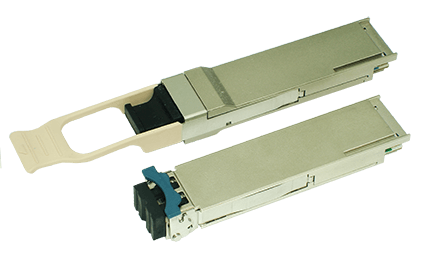
The Quad Small Form-factor Pluggable (QSFP) is a compact, hot-pluggabletransceiver used for data communications applications.
The form factor and electrical interface are specified by a multi-source agreement (MSA) under the auspices of the Small Form Factor Committee. It interfaces networking hardware to a fiber optic cable or active or passive electrical copper connection. It is an industry format jointly developed and supported by many network component vendors, allowing data rates from 4×10 Gbit/s. The format specification is evolving to enable higher data rates; as of May 2013, highest possible rate is 4×28 Gbit/s (also known as QSFP28).
Type:
QSFP transceivers are available with a variety of transmitter and receiver types, allowing users to select the appropriate transceiver for each link to provide the required optical reach over the available optical fiber type (e.g. multi-mode fiber or single-mode fiber). QSFP modules are commonly available in several different categories:
4 x 4 Gbit/s QSFP
The original QSFP document specified four channels carrying Gigabit Ethernet, 4GFC (FiberChannel), or DDR InfiniBand.
4 x 10 Gbit/s QSFP+
QSFP+ is an evolution of QSFP to support four 10 Gbit/sec channels carrying 10 Gigabit Ethernet, 10GFC FiberChannel, or QDR InfiniBand. The 4 channels can also be combined into a single 40 Gigabit Ethernet link.
4 x 14 Gbit/s QSFP+ (QSFP14)
The QSFP14 standard is designed to carry FDR InfiniBand and SAS-3.
4 x 28 Gbit/s QSFP+ (QSFP28)
The QSFP28 standard is designed to carry 100 Gigabit Ethernet or EDR InfiniBand. This transceiver type is also used with direct-attach breakout cables to adapt a single 100GbE port to four independent 25 gigabit ethernet ports (QSFP28-to-4x-SFP28). Sometimes this transceiver type is also referred to as “QSFP100” or “100G QSFP” for sake of simplicity.
Fanout:
Switch and router manufacturers implementing QSFP ports in their products frequently allow for the use of a single QSFP port as four independent 10 gigabit ethernet connections, greatly increasing port density in a 1U height 24-port switch (24 40Gb ports x 4 = 96 10GbE).
From Wikipedia, the free encyclopedia

